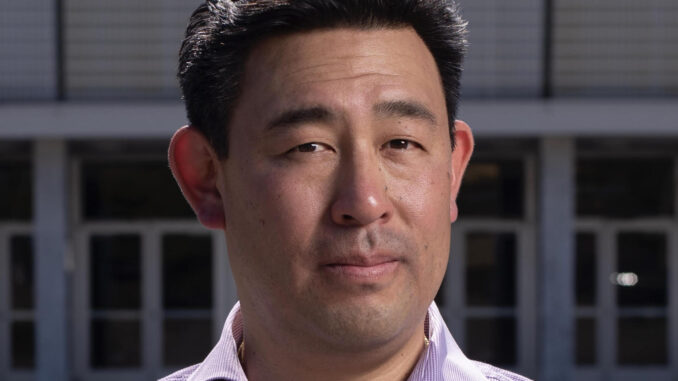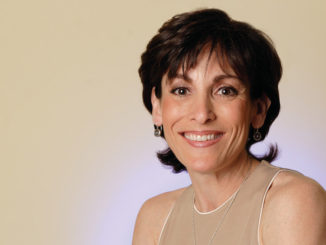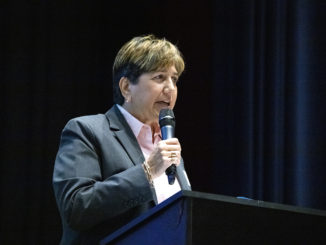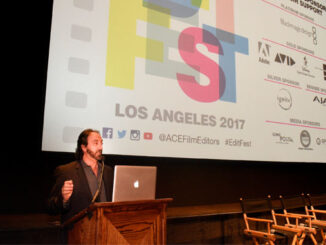
by Rob Feld
Mark Yoshikawa, ACE, has been privileged with some rarified experiences as an editor.
From cutting his teeth as an assistant editor on Christopher Guest comedies to assuming lead editor positions on Terrence Malick’s stream-of-consciousness films as well as cutting massive studio franchises like “The Hunger Games: Mockingjay,” it would be a challenge to pigeonhole his career.
Yoshikawa discovered editing in the 1980’s, making mix tapes and “dumb movies” with his family VHS camera, eventually realizing he could cut on two VCR’s in his living room rather than edit in-camera. “The whole art of filmmaking and editing opened up for me,” he recalled. He attended UC Santa Barbara for Film Studies and found his calling cutting 16mm film on Moviolas and a Steenbeck. “I loved putting together the pieces of a puzzle in a dark room, alone with my thoughts,” he said.
After college, Yoshikawa moved to Los Angeles and found assistant editing work for ultra-low budget, straight-to-video outfits, cutting 35mm film even though his output was destined to live only VHS bargain bins. “As it is with most endeavors,” he says, “the important thing was more about the people you met than the specific project you were working on.”
His most recent project is Lisa Joy’s “Reminiscence,” a memory-driven sci-fi noir, heavy on visual effects and atmosphere. In the film, which opens Friday, sea-levels have flooded Miami and scientist Nick Bannister (Hugh Jackman) offers clients the opportunity to relive memories of their choosing. When the memories of a client implicate another client-turned-lover, Mae (Rebecca Ferguson), in a series of brutal crimes, however, Bannister is forced into the past himself, to discover the true nature of his new love.
For Yoshikawa, it meant pre-editing scenes that would be played back on set by Bannister’s “machine” in another scene, and being on set with Joy every day to plan and manage the translation from technical challenge to story. “It was an exhilarating process,” he said, “and I think all it all paid off, allowing the machine to feel as if it really existed on that set.”
An edited version of a conversation with Yoshikawa follows:
CineMontage: What was the most useful thing you learned from a mentor?
Mark Yoshikawa: I was lucky to have started my career at a time when editing crews were relatively large because the 35mm celluloid film was printed at the lab, prepped in editorial, screened at dailies, telecined overnight, and digitized into the Avid. I learned every step of the process and had a front row seat to learn the craft of editing from two extraordinary mentors: Richard Chew and Robert Leighton. My first big break, union job was with Richard Chew on “That Thing You Do!” Growing up, I was only aware of the names of three film editors because their credits played at the end of my favorite movie, “Star Wars.” One of those names was Richard Chew. I wondered to myself if that name belonged to an actual Asian American man who helped make this cool movie. His name alone served as a role model, long before I was even aware of it myself. I learned from Richard that being the lead editor is only 50 percent about editing the film. That’s the fun part. The rest of the time is spent as a political diplomat, project manager, fireman, scheduler, negotiator, and sometimes therapist. I learned how to keep an even temperament and good cheer in the editing room, while doing a solid job and working hard.
CineMontage: Two of your early assistant experiences were on Christopher Guest films: “Best in Show” and “A Mighty Wind.” What did you learn about the craft of editing from those largely improvised films?
Yoshikawa: The other notable editing mentor of mine was Bob Leighton. I learned from Bob’s style that editing rooms do not need to be high-stress environments. Chris loves to golf, so every lunchtime we would play a full round of “office golf,” putting golf balls through the hallways of Castle Rock. I would admire the way Bob made a point of watching every single piece of film that was shot, just to make sure he gave everything an equal chance of being used. He used his best instincts for what was funny and what timing worked for any particular scene. The biggest lesson I learned from Bob was to trust your instincts, which is basically all editing is, in my opinion. Cut to the next thing that you yourself would want to see and hopefully that’s exactly what the viewer also wants to see, making the edit invisible.
CineMontage: You have had multiple collaborations with Terrence Malick, starting with your first full editor credit on “The New World.” What did your creative process together first look like and how did it evolve over time?
Yoshikawa: I came to work on “The New World” when Richard was hired to start the movie. When they wrapped, we all traveled to Austin for post-production, which is where Terry lives. Initially I came onto the projects as a 1st AE/Associate Editor; however, I quickly found myself charged with editing a significant section of the movie. The movie was split into four sections and the others were edited by Richard, Hank Corwin, and Saar Klein. At a certain point, the other editors graciously agreed that I had been contributing an equal amount of editing as they and they promoted me to full editor. After the three of them left the project, I ended up being the lead editor for the final nine months of post. A similar pattern followed on “The Tree of Life;” that is, there were several editors but I was put in charge of pulling it all together, staying on from beginning to end. “Landing the plane,” as Terry and producer Sarah Green liked to say.
Working with Terry was a unique experience, to say the least. He is such a kind and pleasant man, full of wonder and joy and incredible intelligence. He is also one of the hardest working directors that I’ve ever worked with. He always seemed to be writing voiceover or checking on edits, bouncing between rooms. We’d often just spend long parts of the day talking in metaphors about how to approach recutting the film with fresh eyes. He is a reactive filmmaker, so he’d encourage his editors to surprise him and do something unexpected. The greatest sin was to perfect something to the point that it lost all spontaneity and life. He loved the feeling of randomness, although the result was ultimately a finely crafted “randomness.”
Over the course of four films with Terry, I spent a lot of time in Austin. To say we were “bunkered down” during the editing process is probably an understatement. Because his films are often very subjective in their “stream-of-consciousness” style of editing, we never really knew how close we were getting to a finish-line. I believe that Terry loves the process of filmmaking more than achieving an end product of a film. As a result, I tried to enjoy the process too, along with some delicious BBQ and Longhorn football games.
CineMontage: What is the key to cutting a Malick film?
Yoshikawa: The most important thing to cutting a Malick film is to release yourself from all prior conceptions of how to edit a movie. This is a bit of hyperbole but very true in many ways. In editing, the main thing that Terry always wanted to avoid was the feeling of intentionality or sensing the “filmmaker’s hand” in any way. This could be applied to the choices in performance, the use of shot/reverse shot coverage, the placement of music or practically anything that an editor’s normal instincts would favor. For example, he would often ask, “Did you place that specific line of voiceover on that shot on purpose?” I learned to start placing voiceover with the picture track off, so that I knew the general area it would land but not the exact frame. Remarkably, the V.O. usually seemed to contain more truth that way. Our mantra was always that if something rang false or too “presented” to the viewer, we just cut it out. Sometimes by doing this, it resulted in a jump cut that inherently had more life and energy in it.
CineMontage: You have worked with a wide variety of directors. Is there a process you like to put into place or is it totally director-dependent?
Yoshikawa: The Malick style of editing is the exact opposite when working with a director like Francis Lawrence on “The Hunger Games: Mockingjay” movies. Francis knows exactly what he wants and how to achieve it, resulting in beautifully crafted images and stories. I am currently working on another feature with him and everything is “intentional,” in the best way possible. When dealing with heavy VFX shows, pre-planning and solid execution are vital to the process. Other directors I’ve worked with also have their own special intuition about what works best for the material as they’ve shot it. For example, when I edited the pilot for “Succession,” I had to trust in the fact that Adam McKay was on the same wavelength as I was in terms of timing and performance choices. There is such a specific balance of comedy and drama in that show. When he confirmed that I was making all the right choices, it gave me more confidence to continue with bolder cuts and crafting of character. I believe half of the work in finding a successful editor/director relationship is simply sharing similar instincts. If as an editor I’m consistently favoring a different performance choice or rhythm than the director, then it’s going be a rougher road to arrive at a final cut.
CineMontage: Had you worked with Lisa Joy on “Westworld” before “Reminiscence?” What did your process look like with her?
Yoshikawa: After the pilot of “Westworld” was completed and green-lit, I came on to edit the second episode. I first met Lisa at the “tone meeting” for episode 102 and was immediately struck by her energy, enthusiasm, intelligence, and story sense, not to mention that she’s just really fun to be around. When I was asked to join the crew of “Reminiscence,” the script was brilliant and I looked forward to reuniting with much of the crew I’d worked with before. This being Lisa’s first feature, she was quick to “know what she didn’t know,” asked all the right questions, and surrounded herself with the people who could help her guide the ship. She had the whole movie in her mind and trusted those around her to help bring her vision to the big screen.
The first thing Lisa said to me was, “I’m going to need you on set in New Orleans.” I’ve worked on location plenty of times, but when she said “on set” she meant “on set!” Because of the nature of the story, there were scenes that needed to be “pre-edited” before being played back in another scene to be shot later in the shooting schedule. At the core of the film, there is a machine that reads a person’s memories and renders it three dimensionally on a circular platform. Lisa wanted the actors to react to the actual image on the set, so a method was created by VFX Supervisor Bruce Jones that allowed for the actual footage to be projected onto a screen that essentially created a 3D image. This meant that I needed to edit the elements for these scenes three times: first as the “memory” images, second as they were played back on the machine, and finally as a final composite making the action match in continuity between cuts and coverage.
There were days I would meet with Lisa before call time. She’d take a look at how I’d edited a “memory” scene (which we called the A side) and then go to the set to shoot the coverage of seeing it projected on the machine (which we called the B side). This took a lot of coordination by the 1st AE Fulvio Valsangiacomo, VFX Editor Peggy Eghbalian, and the entire crew. Luckily, our editing room was close to the stage because we were often called upon to run down to the set to confirm the proper camera angles that would match the “memory” footage that was already cut in the Avid.
CineMontage: What was the narrative challenge presented by “Reminiscence”?
Yoshikawa: I have always loved non-linear narratives and the various methods used to pull them off. It wasn’t until I was deep into the editor’s cut that I realized that Lisa had built into her script such an inventive way to root the non-linear storytelling into a practical device at the center of the drama. Every time a character uses “the tank” to relive a memory, it is essentially a flashback but from a very specific perspective. Through editing, we were able to craft the story in a way that would gradually mete out the narrative information for maximum dramatic effect, based on whose memory we were in. As most filmmakers know, part of the magic of editing is being able to restructure, repurpose, or omit entire scenes in order to better serve the overall story. To do this in “Reminiscence” involved some extra math because we needed to make sure each “memory” followed the rules of the machine that we had established. For example, to bolster the relationship between Nick and Mae earlier in the narrative, we moved a romantic scene from later in the movie up to the first act. This was best for the overall arc of the story, but we had to justify its new placement since it wasn’t simply a flashback. Nothing in the story is merely a memory. The non-linear scenes had to be grounded in the logic that we had already set up for the audience.
Tonally, I loved the mix of near future sci-fi and film noir that Lisa wrote into the script. However, rather than creating a dark and shadowy world that often accompanies both of those genres, “Reminiscence” basks in the baking hot sun of Miami in the not-to-distant future. Nick Bannister is essentially filling the role of a detective from a Humphrey Bogart classic. Hugh Jackman has such an incredible voice for voiceover. It often gave me chills to lay it into the Avid with the right music and feel his voice boom through the speakers. Also, if you study the film closely enough, there is even a special meaning of the voiceover itself. I don’t want to spoil anything, but the voiceover had to follow certain narrative rules as well.
Working on “Reminiscence” was one of my favorite editing experiences in my career. The crew and cast were all amazing and the story was top-notch. A few weeks after returning from New Orleans and starting post-production, the pandemic forced us all out of the office and we essentially edited the entire movie from our respective homes. We finished post through a combination of Zooming, live streaming cuts, and eventual socially distanced sound mixes, DI, and screenings. My wife said that she never really knew what I did at work for all these years. She certainly learned the hard way since my editing suite was set up in our living room!
I have always loved editing. I am constantly surprised at the fact that no matter how much I think I know how a cut will look by splicing two shots together, the magic of their juxtaposition creates a feeling that I could not have anticipated. I hope the audience gets just as much of a thrill as I do by watching the finished product.






